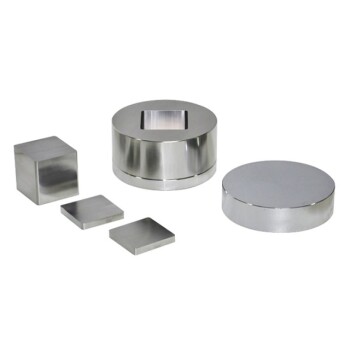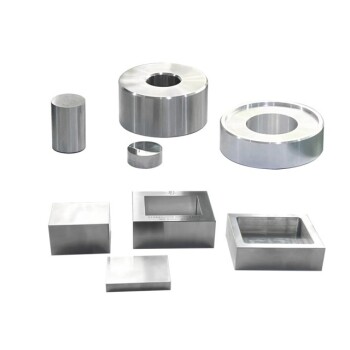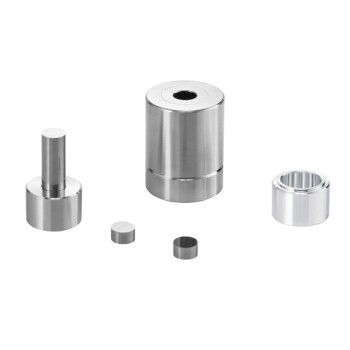Lab press molds are versatile tools used for forming and testing a wide range of samples. Our molds come in a complete range of sizes and have interchangeable accessories. These molds are commonly used in various fields such as battery, superconductor, cement, ceramics, catalysis, silicate, powder metallurgy, sea mud analysis, biochemical analysis, and new material sample preparation research and development. They can also be used with testing instruments like calcium iron, infrared, X-ray fluorescence, and others.
Toggle Categories
Get Instant Support
Choose your preferred way to connect with our team
-
Get Free Quote Fill out form for detailed pricing
-
Send Email Detailed inquiry support
-
WhatsApp Quick mobile chat
Response Time
Within 8 hours on working days, 24 hours on holidays
Molds & Accessories

Infrared Heating Quantitative Flat Plate Press Mold
Item Number : PMHD

Cylindrical Lab Electric Heating Press Mold for Laboratory Applications
Item Number : PMH

Double Plate Heating Press Mold for Lab
Item Number : PMD

Isostatic Molding Pressing Molds for Lab
Item Number : PIPM

Square Lab Press Mold for Laboratory Applications
Item Number : PMS

Cylindrical Press Mold for Lab Applications
Item Number : PMC

Special Heat Press Mold for Lab Use
Item Number : PCHF

Carbide Lab Press Mold for Laboratory Applications
Item Number : PMW

Assemble Square Lab Press Mold for Laboratory Applications
Item Number : PMAS

Assemble Lab Cylindrical Press Mold
Item Number : PMAC

XRF Boric Acid Lab Powder Pellet Pressing Mold for Laboratory Use
Item Number : PMXB

XRF & KBR steel ring lab Powder Pellet Pressing Mold for FTIR
Item Number : PMXS

XRF & KBR plastic ring lab Powder Pellet Pressing Mold for FTIR
Item Number : PMXP

Special Shape Press Mold for Lab
Item Number : PMT

Button Battery Tablet Press Sealing Mold for Lab Use
Item Number : PMN

Button Battery Disassembly and Sealing Mold for Lab Use
Item Number : PCKM

Square Bidirectional Pressure Mold for Lab Use
Item Number : PMS-F

Round Bidirectional Press Mold for Lab
Item Number : PMSY

Cylindrical Press Mold with Scale for Lab
Item Number : PCMC

Anti-Cracking Press Mold for Lab Use
Item Number : PML

Ring Press Mold for Lab Applications
Item Number : PMO

No Demolding Lab Infrared Press Mold for Laboratory Applications
Item Number : PMI
Lab presses come in two main types: floor standing and benchtop devices. They can be customized to meet specific requirements for force and precision. While standard presses are sufficient for most lab applications, some situations call for a more specialized press that can apply high forces or move with extreme precision.
Lab presses are commonly used for three types of processes: compression molding, transfer molding, and vacuum press applications.
Types of Press Processes
Compression molding
Compression molding is a basic and widely used molding technique. The process involves compressing a bulk material into a mold cavity using a press. The workpiece can be preheated or heated during pressing using heated platens, depending on the material.
This technique is cost-effective and can produce relatively large and complex components. Compression molding is commonly used for molding plastics, fiberglass, and metals. It is particularly useful for producing moderately curved or flat components.
Transfer molding
Transfer molding, also known as compression transfer molding, is a technique that applies pressure to force the material into a mold. This process achieves higher dimensional tolerances, but it requires higher pressures than compression molding.
Transfer molding is commonly used to generate components from resins, forming thermoset products. It is widely used in industries such as construction, electronics, aerospace, and sports equipment manufacturing.
Vacuum press
Vacuum press refers to any type of press where the workpiece is held in an evacuated environment during pressing. This technique can increase production speed, improve quality, and reduce waste materials.
By removing heated gases and trapped air, the vacuum can minimize defects that may occur with compression or transfer molding. Vacuum presses are commonly used in industries where high-quality precision is required, such as manufacturing.
This technique can be used for a wide range of materials, including plastics, composites, and metals. Vacuum presses are particularly useful for producing components with intricate details or complex shapes.
KinTek Lab Press Molds & Accessories
For those looking for reliable and versatile lab press molds, KinTek Lab Press Molds & Accessories is an excellent choice. With a long production history, our lab press molds have been proven to meet the highest standards of quality and performance.
We offer a complete range of molds that can be customized to meet your specific needs. From compression molding to vacuum press applications, our lab press molds are versatile and designed to meet the demands of any lab application.
FAQ
What Is The Principle Of Tablet Press Molds?
What Is A Lab Press?
What Considerations Should Be Made For Battery Case Gaskets?
What Is A Press Mold?
What Are The Main Types Of Tablet Press Molds?
What Is Isostatic Pressing?
What Are The Benefits Of Isostatic Pressing?
What Is The Purpose Of A Hydraulic Press In Lab?
What Are The Applications Of Pellet Presses?
What Is The Role Of Battery Case Gaskets?
What Is Press Mould In Ceramics?
What Are The Advantages Of Using Tablet Press Molds?
What Are The Types Of Isostatic Pressing?
There are two main types of isostatic pressing:
- Hot Isostatic Pressing (HIP): This type of isostatic pressing uses high temperature and high pressure to consolidate and strengthen the material. The material is heated in a sealed container and then subjected to equal pressure from all directions.
- Cold Isostatic Pressing (CIP): In this type of isostatic pressing, the material is compacted at room temperature using hydraulic pressure. This method is commonly used to form ceramic and metal powders into complex shapes and structures.
What Are Different Type Of Lab Presses?
How Does A Pellet Press Work?
How Do You Prepare Pressed Pellets For XRF?
What Are Lithium-air Battery Cases?
How Are Pellet Molds Used?
What Are The Applications Of Tablet Press Molds?
What Type Of Isostatic Pressing Equipment Do You Have?
What Are The Benefits Of Using A Pellet Press?
What Pressure Should XRF Pellets Be?
How Should Button Battery Cases Be Chosen For Specific Applications?
What Types Of Materials Can Be Pelletized Using Pellet Molds?
What Are The Wet Bag Process And The Dry Bag Process?
The CIP molding process is divided into two methods: the wet bag process and the dry bag process.
Wet bag process:
In this method, the powder material is placed in a flexible mold bag and placed in a pressure vessel filled with high-pressure liquid. This process is ideal for producing multi-shaped products and is suitable for small to large quantities, including large-sized parts.
Dry bag process:
In the dry bag process, a flexible membrane is integrated into the pressure vessel and is used throughout the pressing process. This membrane separates the pressure fluid from the mold, creating a "dry bag." This method is more hygienic as the flexible mold does not get contaminated with wet powder and requires less cleaning of the vessel. It also features fast cycles, making it ideal for mass producing powder products in an automated process.
What Factors Should Be Considered When Selecting A Pellet Press?
What Is The Advantage Of XRF Pressed Pellet Technique?
How Can One Select The Appropriate Pellet Mold For Their Specific Application?
How Long Is Your Delivery Time? If I Want To Customize The Instrument, How Long Does It Take?
REQUEST A QUOTE
Our professional team will reply to you within one business day. Please feel free to contact us!
Related Articles

The Real Reason Your Sintered Parts Crack (And It’s Not the Furnace)
Stop blaming the furnace. Discover the hidden flaw in powder pressing that causes parts to crack and learn how Cold Isostatic Pressing (CIP) offers a permanent fix.

The Architecture of Precision: Mastering the Five-Port Water Bath Electrolytic Cell
Mastering the electrolytic cell is not just about chemistry; it is about discipline. Learn the systematic approach to preparation, operation, and maintenance.

The Architecture of Control: Mastering the Super-Sealed Electrolytic Cell
Precision in electrochemistry isn't just about theory; it's about mechanical discipline. Learn the critical protocols for super-sealed electrolytic cells.

The Architecture of Control: Why Thermal Stability Defines Electrochemical Precision
Master electrochemical accuracy by understanding the interplay between three-electrode systems and thermal regulation. Eliminate variables to ensure reproducibility.

The Quiet Architecture of Clarity: Preserving Side-Window Optical Cells
Learn the precise protocols for storing optical electrolytic cells. Prevent thermal degradation, chemical etching, and data drift with expert maintenance strategies.

The Silence of the Seal: Why Electrochemical Precision is a Battle Against the Atmosphere
Precision in electrochemistry isn't just about voltage; it's about isolation. Discover how super-sealed cells defeat contamination and define reproducibility.

Why Your Lab Press Fails: It's Not the Tonnage, It's the Steel
Discover the hidden reason your hydraulic press gives inconsistent results. Learn why the choice of steel is more critical than tonnage for safety and accuracy.

The Architecture of Control: Why Thermal Stability Defines Electrolysis Success
Discover how double-layer water-bath electrolytic cells eliminate thermal variables, ensuring accuracy and reproducibility in electrochemical research.

Why Your Lab Pellets Crack: The Hidden Physics of a Perfect Press
Stop blaming your powder. Discover the real reason your lab pellets fail and how a precision hydraulic press solves inconsistent sample prep for good.

Why Your Lab's Hydraulic Press Keeps Failing (It’s Not What You Think)
Discover the three 'silent killers' of lab hydraulic presses, like off-center loading and fluid contamination, and how to prevent costly failures.

Why Your Sample Prep Fails: The Hidden Flaw in Your Hydraulic Press
Frustrated with cracked pellets and inconsistent lab press results? Discover the hidden material flaw in your equipment and how to fix it for good.

Why Your High-Temperature Furnace Elements Keep Failing (And How to Stop It)
Discover the hidden causes of MoSi2 heating element failure, like pesting and chemical attack, and learn how to achieve reliable, repeatable results.

Why Your High-Temperature Furnace Elements Fail: The Critical Difference in Silicon Carbide
Furnace downtime from failing SiC heating elements costs time and money. Discover the critical material difference that ensures reliability in extreme applications.

Your Hydraulic Press Is Hot. Here’s Why It’s a Bigger Problem Than You Think.
Is your lab's hydraulic press overheating? Learn why this is a critical sign of wasted energy and impending failure, and how to fix it permanently.

Freeze-Drying Decoded: The Science Behind Preserving Food, Medicine, and Research Materials
Discover how freeze-drying preserves food, medicine, and research materials with unmatched efficiency. Learn the science behind lyophilization and its applications.

How Cascade Refrigeration Powers Ultra-Low Temperature Freezers Beyond Single-Stage Limits
Learn how cascade refrigeration enables ultra-low temperature freezers to reach -80°C and beyond, overcoming single-stage system limitations for critical sample storage.

Beyond the Spec Sheet: Matching Freeze Dryer Capabilities to Your Application's Critical Needs
Choose the right freeze dryer for pharma, food, or biotech. Key specs like cold trap temp, vacuum, and cooling rate impact drying speed and product quality.

PTFE seals: the invisible guardian of industrial leakage prevention
PTFE Seals are used to prevent liquid or gas leakage and are widely used in valves, pumps, and piping systems.

How to use PTFE to improve the working efficiency of pumps and valves
Polytetrafluoroethylene (PTFE) has become a key material for improving the efficiency of pumps and valves due to its unique physical and chemical properties.

Application of Liquid Nitrogen in Food Freezing
Explores the use of liquid nitrogen in food freezing, its advantages, methods, equipment, and safety considerations.



